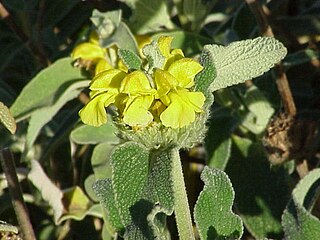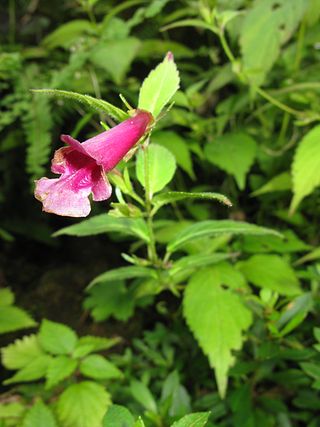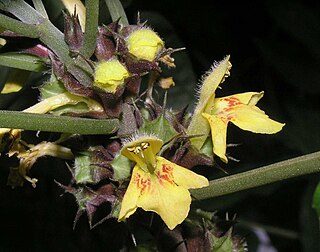
The Lamiaceae or Labiatae are a family of flowering plants commonly known as the mint, deadnettle or sage family. Many of the plants are aromatic in all parts and include widely used culinary herbs like basil, mint, rosemary, sage, savory, marjoram, oregano, hyssop, thyme, lavender, and perilla, as well as other medicinal herbs such as catnip, salvia, bee balm, wild dagga, and oriental motherwort. Some species are shrubs, trees, or, rarely, vines. Many members of the family are widely cultivated, not only for their aromatic qualities, but also their ease of cultivation, since they are readily propagated by stem cuttings. Besides those grown for their edible leaves, some are grown for decorative foliage. Others are grown for seed, such as Salvia hispanica (chia), or for their edible tubers, such as Plectranthus edulis, Plectranthus esculentus, Plectranthus rotundifolius, and Stachys affinis. Many are also grown ornamentally, notably coleus, Plectranthus, and many Salvia species and hybrids.

Rosaceae, the rose family, is a medium-sized family of flowering plants that includes 4,828 known species in 91 genera.

Oryza is a genus of plants in the grass family. It includes the major food crop rice. Members of the genus grow as tall, wetland grasses, growing to 1–2 metres (3–7 ft) tall; the genus includes both annual and perennial species.

Dracocephalum is a genus of flowering plants in the family Lamiaceae, native to temperate regions of the Northern Hemisphere. These flowers, collectively called dragonhead, are annual or perennial herbaceous plants or subshrubs, growing to 15 to 90 centimeters tall. The genus has 89 species as currently circumscribed, which includes the formerly separate genera Hyssopus, Lallemantia, and others. Older circumscriptions include 60 to 70 species.

Stellaria is a genus of about 190 species of flowering plants in the family Caryophyllaceae, with a cosmopolitan distribution. Common names include starwort, stitchwort and chickweed.

Mahonia is a formerly accepted genus of approximately 70 species of shrubs or, rarely, small trees with evergreen leaves in the family Berberidaceae, native to eastern Asia, the Himalaya, North America, and Central America. They are closely related to the genus Berberis and as of 2023 the majority of botanical sources list it as a synonym for Berberis.

Phlomis is a genus of over 100 species of herbaceous plants, subshrubs and shrubs in the mint family Lamiaceae, native from the Mediterranean region east across central Asia to China.

The Myricaceae are a small family of dicotyledonous shrubs and small trees in the order Fagales. There are three genera in the family, although some botanists separate many species from Myrica into a fourth genus Morella. About 55 species are usually accepted in Myrica, one in Canacomyrica, and one in Comptonia.

Vitex is a genus of flowering plants in the sage family Lamiaceae. It has about 250 species. Common names include chaste tree or chastetree, traditionally referring to V. agnus-castus, but often applied to other species, as well.

Collinsonia is a genus of flowering plants in the family Lamiaceae. It is native to East Asia and eastern North America. It was named for the English botanist Peter Collinson (1694–1768) by Carl Linnaeus in Species Plantarum in 1753. It is in the tribe Elsholtzieae, a small tribe of only 5 genera. In order of their number of species, they are Elsholtzia, Mosla, Collinsonia, Perilla, and Perillula.

Salvia is the largest genus of plants in the sage family Lamiaceae, with nearly 1000 species of shrubs, herbaceous perennials, and annuals. Within the Lamiaceae, Salvia is part of the tribe Mentheae within the subfamily Nepetoideae. One of several genera commonly referred to as sage, it includes two widely used herbs, Salvia officinalis and Salvia rosmarinus.

Pestalotiopsis is a genus of ascomycete fungi in the Sporocadaceae family.

Chelonopsis is a genus of plants in the family Lamiaceae, first described in 1865. It is native to China, Japan, and the Western Himalayas.
Phlomoides sagittata is a species of flowering plant in the family Lamiaceae. It is a perennial native to Kyrgyzstan and Xinjiang in central Asia.
Ombrocharis is a genus of flowering plant in the tribe Elsholtzieae of the family Lamiaceae, first described in 1936. It contains only one known species, Ombrocharis dulcis, endemic to Hunan Province in China.

Paraphlomis is a genus of flowering plants in the mint family, Lamiaceae, first described in 1901. It is native to China, Himalayas, and Southeast Asia.

Phlomoides tuberosa, the sage-leaf mullein, is a perennial herbaceous flowering plant in the family Lamiaceae, native to China, Kazakhstan, Kyrgyzstan, Mongolia, Russia; SW Asia and Europe. Enlarged, tuberous roots give rise to erect stems to 150 cm bearing purple-red flowers.

Phlomoides, also called Jerusalem sage and Lampwick plant, is a genus of over 130 species of flowering plants in the family Lamiaceae, native from the eastern Mediterranean Basin through Eastern Europe, western and central Asia, and the Indian subcontinent to China, Korea, and the Russian Far East. Phlomoides now comprises many species formerly in the genus Phlomis, and the former genera Eremostachys, Lamiophlomis, Notochaete, and Pseuderemostachys.

Perilla is a genus consisting of one major Asiatic crop species Perilla frutescens and a few wild species in nature belonging to the mint family, Lamiaceae. The genus encompasses several distinct varieties of Asian herb, seed, and vegetable crop, including P. frutescens (deulkkae) and P. frutescens var. crispa (shiso). The genus name Perilla is also a frequently employed common name ("perilla"), applicable to all varieties. Perilla varieties are cross-fertile and intra-specific hybridization occurs naturally. Some varieties are considered invasive.

Lamioideae is a subfamily of plants in the family Lamiaceae.
















